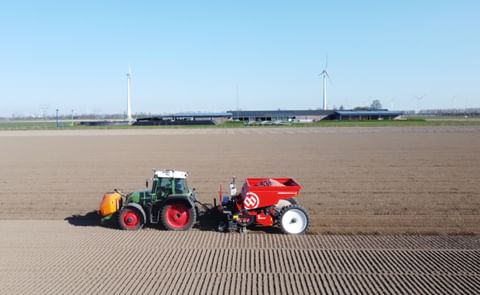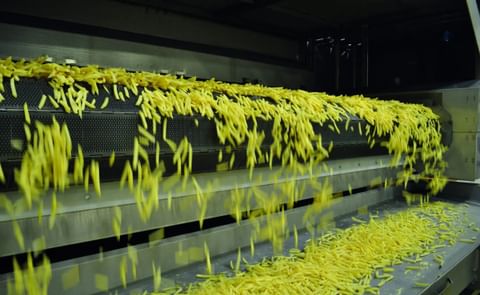Jans Klok, knowledge coordinator at Avebe.
Higher potato yield with the Royal Avebe fertilization strategy

Due to the current scarcity of fertilizers, the 'red areas' and the increasing production costs, efficient nitrogen fertilization is becoming increasingly important. Patrick Riek, account manager at Royal Avebe, has full confidence in the nitrogen-reduced fertilization strategy for good cultivation and fertilization advice.
Patrick Riek, account manager at Royal Avebe:
In addition to a reduced amount of nitrogen, the moment that plants are fed with fertilizers is also crucial for the highest possible yield.
Patrick Riek:
Added value for the grower
By reducing the amount of nitrogen fertilizers, the nitrogen efficiency (ie the proportion of the entire N application actually used by the plant) can be significantly increased.
Patrick Riek:
Good prospects for starch cultivation
The increase in added value for the grower is the result of years of research that Avebe carries out on the countless trial and demo fields. Successfully! The result is a thorough fertilization advice with a lower N dose.
Patrick looks to the future with confidence and has high expectations in particular for the development of sustainable and efficient cultivation methods and for the breeding of both disease-tolerant varieties and varieties that are resistant to viruses and pests.
Sustainable potato cultivation is based on more with less: more yield with a lower footprint. Royal Avebe helps its growers with low-input varieties with a higher nitrogen efficiency. Knowledge coordinator Jans Klok sees good opportunities for the future.
Reduction of CO2 emissions
In the special sustainability demo, the standard variety Seresta is compared with the varieties Adelinde and Avenger. Seresta is known to be susceptible to phytophthora and needs a lot of nitrogen, says Klok.
Jans Klok:
Compared to Seresta, Avenger scores 45 percent less environmental impact on aquatic life and 67 percent less on benthic life.
Jans Klok:
According to Klok, sustainable potato cultivation and political developments do not always go hand in hand.
The first draft of the 7th Nitrates Directive Action Program stated that growers should sow a catch crop before 1 October, while after 1 September almost 9 tons of starch potatoes per hectare will still grow.
Jans Klok:
Patrick Riek, account manager at Royal Avebe:
"The years of research on our trial and demo fields show that we achieve a significantly higher starch yield with our fertilization recommendation of 120 kg nitrogen per hectare, instead of the generally maintained 160 to 180 kg nitrogen per hectare."From leaf growth to tuber setting – the decisive moment
"Based on plant physiology, this can be explained as follows: a high N-dose (nitrogen) at the beginning of the growing season ensures better growth of the leaf mass of the potato plant."
"The additional advantage of a larger leaf mass decreases sharply above a certain leaf mass due to self-shading and the greater need for maintenance."
"The fertilizers that only stimulate leaf growth, but do not lead to a higher yield, can therefore be saved."
In addition to a reduced amount of nitrogen, the moment that plants are fed with fertilizers is also crucial for the highest possible yield.
Patrick Riek:
"About the moment between crop closure and flowering, the plants must have sufficient nutrients and energy to achieve the desired yield."During this transition period, the plant needs the most nitrogen.
Added value for the grower
By reducing the amount of nitrogen fertilizers, the nitrogen efficiency (ie the proportion of the entire N application actually used by the plant) can be significantly increased.
Patrick Riek:
"Based on our fertilization advice, growers can save up to EUR 100 (USD 100) per hectare with the current fertilizer prices."According to Patrick, Avebe has therefore developed a future-proof fertilization strategy that can be the solution for the current nitrogen problem.
"Together with the resulting higher starch yield, which, based on a calculation of one tonne per hectare, means around EUR 350 to 400 (USD 350 to 400) more for the grower, we can speak of considerable added value for the grower."
Good prospects for starch cultivation
The increase in added value for the grower is the result of years of research that Avebe carries out on the countless trial and demo fields. Successfully! The result is a thorough fertilization advice with a lower N dose.
Patrick looks to the future with confidence and has high expectations in particular for the development of sustainable and efficient cultivation methods and for the breeding of both disease-tolerant varieties and varieties that are resistant to viruses and pests.
Sustainable potato cultivation is based on more with less: more yield with a lower footprint. Royal Avebe helps its growers with low-input varieties with a higher nitrogen efficiency. Knowledge coordinator Jans Klok sees good opportunities for the future.
Reduction of CO2 emissions
In the special sustainability demo, the standard variety Seresta is compared with the varieties Adelinde and Avenger. Seresta is known to be susceptible to phytophthora and needs a lot of nitrogen, says Klok.
Jans Klok:
"If we want to reduce CO2 emissions, this can be influenced by the nitrogen addition. Both Adelinde and Avenger can use 60 kg less nitrogen/ha compared to Seresta."A major advantage of Avenger over Adelinde is that the variety has better phytophthora resistance. As a result, Avenger needs fewer treatments against phytophthora than the other two varieties.
"If you apply 10 kg less nitrogen, CO2 emissions fall by 3 percent. The 7th Nitrates Directive Action Program also focuses primarily on nitrogen efficiency."
Compared to Seresta, Avenger scores 45 percent less environmental impact on aquatic life and 67 percent less on benthic life.
Jans Klok:
"If we convert the use of nitrogen and the improved phytophthora resistance into money."Practice versus politics
According to Klok, sustainable potato cultivation and political developments do not always go hand in hand.
The first draft of the 7th Nitrates Directive Action Program stated that growers should sow a catch crop before 1 October, while after 1 September almost 9 tons of starch potatoes per hectare will still grow.
Jans Klok:
"It is known that 1 tonne of potatoes contains 4 kg of nitrogen. So with 9 tons you remove 36 kg of nitrogen per hectare from the land. A catch crop can retain a maximum of 22 kg of nitrogen per hectare in this area."
"Avebe has introduced this point to the Ministry of Agriculture, Nature and Food Quality and the rule has been relaxed in the final 7th Nitrates Directive Action Programme."
Like to receive news like this by email? Join and Subscribe!
NEW! Join Our BlueSky Channel for regular updates!
Highlighted Company
Potato varieties mentioned
Sponsored Content
Sponsored Content
Sponsored Content
Sponsored Content
Sponsored Content







